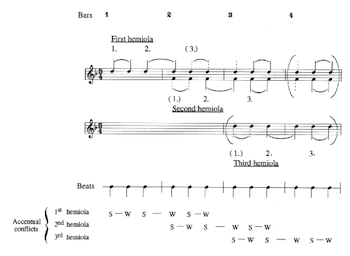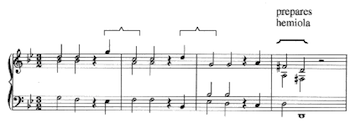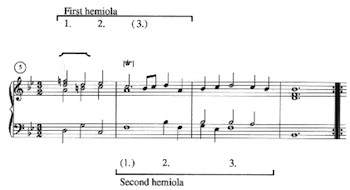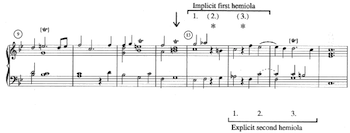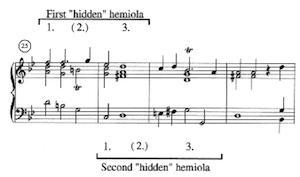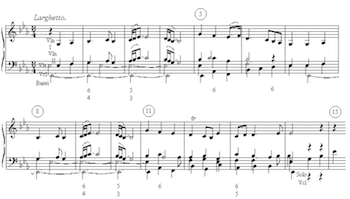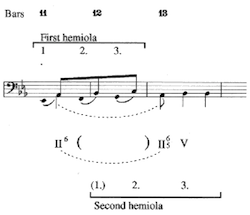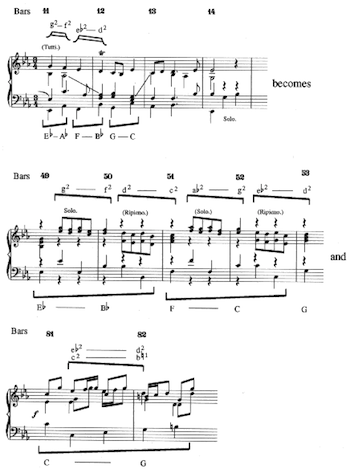More on Handel and the Hemiola: Overlapping Hemiolas
Channan Willner
KEYWORDS: hemiola, sarabande, courante, musette, expansion, contraction, Handel, J.S. Bach, Mozart
ABSTRACT: To the three categories of hemiolas I identified in an earlier study I add a fourth, overlapping hemiolas. Particularly in the Baroque repertoire, and especially in the works of Handel, there are frequent instances of two successive two-bar hemiolas that overlap because they are collapsed onto three bars. I examine the larger context in which their preparation, elaboration, and peroration may represent central compositional issues, especially in light of the brevity of most Baroque compositions.
Copyright © 1996 Society for Music Theory
[1] In my article, “The Two-Length Bar Revisited: Handel and the Hemiola” (Göttinger Händel-Beiträge, Vol. 4 [1991], pages 208–31), I attempted to identify several categories of Handelian hemiolas—cadential, expansion, and contraction hemiolas—in the hope that their establishment would help us sort out some of the complexities of Handel’s phrase rhythm (and that of other composers, for that matter). I also pointed to several types of hemiola that could not be readily stratified. If nothing else, the article demonstrated that the hemiola could assume a great variety of contextually defined senses. The present update is designed to complement my earlier study by pointing to an additional category—overlapping hemiolas—and by assessing its impact on the surrounding elements of the design. After establishing this new category in the first part, I shall seek to revise two of my earlier readings in the second part and, in closing, point to several relatively recent studies that illuminate this complex and elusive subject.(1)
[2] Among the difficulties of observing the hemiola and approaching it from a theoretical or analytical perspective is the high degree of uncertainty (not to say ambiguity) that surrounds its articulation. The compositional environment will often suggest hemiolas by emphasizing the third beat of a measure (or the second beat in the following measure) through thematic, textural, harmonic, or registral stresses of varying impact, but it will not necessarily follow it up with an explicitly marked hemiola formation. In other words, it will stop just short of defining three contiguous long, hemiolic beats (each divided into two short internal beats, one strong, the other weak) over the span of two measures in triple meter. Compounding the consequent uncertainty is the well-established absence of a requirement for the hemiola to be articulated by both outer voices: The bass may not necessarily support the suggestion of a hemiola by the upper voice, and the upper voice will not necessarily corroborate its realization by the bass. Especially in such cases, the emphases articulating the hemiola will accrue largely through a series of design stresses—rhythmic accents that (as just intimated) are due to melodic, textural, harmonic, or registral intensification of purely local origin, at the very surface. In borderline instances, it is up to such design accents to try and supplant the metrical accents of the notated meter, whose supporting grid extends to deeper levels of durational structure. And indeed, there are many cases where it is in fact the notated meter that wins out. (On the other hand, the presence of several hemiolas may foster parallelisms that will reinforce the design stresses in potentially ambiguous passages.) Since not all voices necessarily participate in the hemiolic activity, the hemiola’s effect on the composition’s harmonic rhythm and other underlying paces will vary considerably from one hemiola to another.
[3] The formation I call overlapping hemiolas, which may be defined as a set of two hemiolas collapsed onto three measures, makes use of just this possibility of articulating the hemiola incompletely; see Example 1, which also depicts the possibility of a third overlapping hemiola, sometimes found in Bach and occasionally in Handel. The formation often begins, somewhat unexpectedly and perhaps furtively, at a distance of three, rather than two, bars from the closing cadential progression of a phrase or subphrase, namely at the beginning of the group. Its location lends it a thematic weight different in nature, if not in emphasis or impact, from that of hemiolas that appear closer to the cadential chords of the group in question; its length allows it to shape the entire group in a way no single hemiola could. (Single hemiolas may, of course, also appear at the beginning of a group without being followed by an overlapping hemiola.)
[4] In the first bar of the formation, two-beat patterns in the soprano or bass (or in both) briefly contradict the notated meter and establish the first hemiola. In the second bar, the hemiola’s articulation becomes uncertain, as the broken stems in Example 1 show. On the one hand, the metrical accent on the first beat is not attenuated to the same degree it usually is in hemiola formations; on the other, the expected stress on the second beat is elided or contradicted by adjacent stresses. The first two beats of the second measure may be regarded as a grey area, a durational “pivot zone,” that plays host to two events: the premature peroration of the first hemiola, and the sly entrance of the second hemiola. For the second hemiola enters, however surreptitiously, at the downbeat of this second measure; it now begins to make its presence known. As a result, the first hemiola’s division of long hemiolic beats into strong and weak internal beats undergoes metrical reinterpretation, as the diagram of accentual conflicts at the bottom of Example 1 demonstrates. The first hemiola’s conclusion thus assumes a jagged and unsettled quality, a sense of tentative and incomplete realization that may have significant repercussions for the metrical design in the phrases and sections that follow. Once the third measure has been reached, the outline of the second hemiola emerges quite clearly. Because it is usually the second hemiola that enlists the cadential support of the bass, it brings the formation to a decisive close and at the same time sends out the signal that it has neutralized and absorbed the first hemiola.
Example 2. Handel, Suite in G minor (1720), Sarabande, mm. 1–4
(click to enlarge and listen)
Example 3. Handel, Suite in G minor (1720), Sarabande, mm. 5–8
(click to enlarge and listen)
[5] To illustrate the foregoing explanation and its more extended ramifications, I should like to offer several observations on the appearance of overlapping hemiolas in the Sarabande from Handel’s G-minor Suite of 1720. The Sarabande opens with a four-bar subphrase that strikes an immediately memorable impression by replacing the expected, largely stepwise outlines of the typical sarabande melody with a series of bold leaps; see the braces in Example 2. While these help underscore the Sarabande’s four-bar grouping they also prevent it from assuming the predictable melodic contours of the genre. The overlapping hemiolas occupy bars 5–7, much of the second four-bar subphrase (Example 3).
[6] The two-chord patterns in bars 5–6 begin to establish a hemiola and
continue through to the downbeat of bar 6 (see the brackets atop
Example 3). The melodic line’s two pairs of descending thirds,
[7] At the downbeat of bar 6, then, two events overlap: The statement
of the hemiola’s fourth, weak internal beat, and the beginning of an
unexpectedly sustained F-major chord, whose continuation through
the second beat of the measure supports the notated meter as
established in bars 1–4 and generates what Joel Lester called a
“durational accent.”(2) Not only is the fifth, strong internal beat
of the hemiola elided—it is subsequently contradicted by the third beat
of bar 6, which initiates a faster melodic pace of quarter notes. The
group of quarter notes, supported by a strong cadential progression
in the bass, straddles the downbeat of bar 7 and describes a typical
cadential hemiola (Example 3). The gradual realization of this second
hemiola, then, overlaps the equally gradual peroration of the first
hemiola; both realization and peroration are the subject matter of bar
6, whose first two beats emerge as the “pivot zone” referred to earlier.
Note how the movement in parallel tenths,
[8] Because the overlapping hemiolas span three bars and occupy the greater part of a four-bar subphrase, the temporary metrical uncertainty they portray in their central measure has the potential for creating a genuine disturbance in the rhythmic flux of the piece. To foster a compositional and rhetorical milieu in which such disturbance will realize its assigned effect without appearing out of line, Handel often prepares the onset of overlapping hemiolas in some way during the preceding passages and then only gradually allows them to dissipate in the phrase or phrases that follow. By the time their peroration is completed, then, their very presence in the piece, as such, will likely have promoted additional rhythmic dialectics, and these might have in turn become intimately linked to the compositional essence of the piece.
[9] The two-chord patterns that launch the first hemiola in bars 5–6 are
prepared by the falling third
[10] Let us look now at several later allusions to the overlapping hemiolas; these, too, help prevent the remaining three eight-bar phrases from outlining an excessively mechanical profile. Although the four-bar group that follows the double bar brings back the rhythmic outlines of bars 1–4, the unexpected entrance of a two-beat G major chord on the second beat of bar 12, at the close of the group (and in the manner of a written-out sforzato), nearly usurps the cadential status of F, the subtonic that entered on the downbeat of the measure (see the arrow in Example 4). It is as if Handel insisted on affirming, following the upheaval of bars 5–7, that we are indeed listening to a Sarabande, but that further upheaval is in store for us as well.(3) The resulting metrical imbalance makes it possible for the new thematic material that enters in bar 13 to chart a more flexible course than the opening of a foursquare group would normally allow. The mysterious quarter-note rests on the third beat of bar 13 and the second beat of bar 14 represent suppressed accents: On account of their proximity they seem jointly to allude to a hemiola, if not to express one explicitly (see the asterisks in Example 4; the rest in bar 13, though a reference to the rest in bar 1, is dramatized by its contradiction of the two-beat G-major chord in bar 12). As in bar 6, earlier, their more decisive continuation—namely, at the third beat of bar 14—establishes a typical cadential hemiola (bars 14–15). Like the cadential hemiola of bars 6–7, this new hemiola absorbs the uncertainties of bars 13–14. One could, then, view the events in bars 13–15 as a partly silent, hidden reminiscence of those in bars 5–7. Given the relative surface regularity of bars 9–12, which recalls that of bars 1–4, one could take the correspondence one step further and regard the route followed by the Sarabande’s second phrase as parallel to that followed by its first phrase.(4)
[11] The uncertainties and tensions of the Sarabande’s overlapping hemiolas find their complete peroration only in its remaining two phrases (bars 17–24 and 25–32). The subphrase in bars 17–20 restores the outlines of bars 1–4 but forgoes the striking leaps of the first subphrase in favor of a more traditionally cantabile, conjunct setting of the characteristic incipit. The following subphrase, in bars 21–24, shows a comparatively mechanical quality (a quality underscored by the repetition of the same subphrase in bars 29–32). The literal transposition of bars 21 and 29 in bars 22 and 30 (a third higher) underscores the insistence of the subphrase’s repeated notes (A4, C5), as well as the closing impulse of its plainly cadential hemiolas (bars 22– 23, 30–31). This is Handel’s response to the accentual irregularities occasioned by the overlapping hemiolas: Though they play their role well, the two subphrases in question count among the less inspired passages in the 1720 collection of suites (the Sarabande dates from about 1703–06, but it was revised for the 1720 publication). Their slight awkwardness exemplifies the difficulties Baroque composers faced when, in the course of very short pieces, they felt need to resolve complex issues they had raised moments earlier but did not quite have the needed durational space in which to work out the resolution.
[12] It is only in the course of bars 25–28, the first subphrase of the closing phrase, that a vestige of genuine tension reemerges. At bar 26, Handel sidesteps the opportunity to present generic repeated-chord patterns (in imitation of bars 17ff. and bar 25) and sustains the second-beat D chord through the end of the measure instead. Handel can thereby suggest a “hidden hemiola” in bars 25–26 without fully realizing it. The seventh chord on G, sustained in different positions through the second and third beats of bar 25, militates against the realization of the hemiola (Example 5). Along the same lines, by beginning bar 27 with two quarter notes, Handel evokes the preceding cadential hemiola (that of bars 22–23) without really articulating it (cf. the brackets in Example 5). As a group, bars 25–27 thus portray an attenuated rhythmic reference to the Sarabande’s temporal peculiarities (the suggestion of hemiolic closure in bars 26 and 27 not being matched by that of hemiolic opening in bars 25 or 26), but at the same time they steer clear of the peculiarities’ actual portrayal—a signal indication that the turbulence of the Sarabande’s temporality has finally reached the point of complete peroration.(5) Though not as elegant as its introduction, Handel’s resolution of the Sarabande’s durational dialectic is emblematic of the dynamic, improvisatory nature of Baroque style, and it embodies a measure of compositional freedom missing perhaps from his later, more closely integrated compositions.
[13] I should like to take the opportunity of writing again about the hemiola to modify my account of the hemiola formations in two of the pieces I presented in “The Two-Length Bar Revisited”: Those in the Courante from Handel’s F minor Suite, and those in the Musette from the G minor Concerto Grosso, Op. 6 No. 6 (Examples 3 and 4 in that article). Even though the hemiolas in each piece appear at the close of a phrase, one could make a plausible case for reading them as constellations of overlapping hemiolas.(6)
[14] In bars 17–19 of the Courante (Example 6 in the present essay),
the upper voice’s first hemiola (bars 17–18) is self-evident; that an
additional, overlapping hemiola spans bars 18–19 in the upper voice
is suggested by the entrance of the bass G at the turn of bar 18, which
underscores the downbeat of the measure, by the subsequent emphasis
on the supertonic ![]()
![]()
![]()
[15] Though it is the second, rather than the first, hemiola that is relatively tentative here—its interpretation is supported by the grouping of the upper voice but contradicted by the return of the bass tone G at the beginning of bar 19—the durationally angular setting of the three-bar segment and its collection of conflicting accents does evoke the thematic and rhythmic contraction typical of overlapping hemiolas and as such assumes growing significance in the course of the piece. First introduced as the climax to a set of imitative entrances of the Courante’s short theme over the dominant (bars 10– 14–17), it reappears in the form of seemingly incidental allusions to the tentative hemiola of bars 18–19 during the cadential progression of bars 27–29 and, more concretely, in the progression of bars 30–32 (and, transposed but complete, in bars 41–43).
Example 7. Handel, Concerto Grosso in G minor, Op. 6, No. 6, Musette, mm. 1–15
(click to enlarge and listen)
Example 8. Handel, Concerto Grosso in G minor, Op. 6, No. 6, Musette, mm. 11–13
(click to enlarge)
Example 9. Handel, Concerto Grosso in G minor, Op. 6, No. 6, Musette, mm. 1–7
(click to enlarge and listen)
Example 10. Handel, Concerto Grosso in G minor, Op. 6, No. 6, Musette, mm. 11–14, 49–53, 81–82
(click to enlarge and listen)
[16] The overlapping hemiolas in the Musette from the G minor
Concerto Grosso (bars 11–13) stand, by contrast, on nearly equal
footing (bars 1–15 are quoted in Example 7 of the present article; my
new analytical observations are illustrated in Examples 8–10). The first hemiola is outlined by three pairs of chords whose articulation of
strong and weak internal beats—SW, SW, SW—supports their
contrapuntal and harmonic priorities. The first chord of each pair
acts as an accented appoggiatura to the second. The metrical
reinterpretation that takes place in the course of bar 12 is made
possible by this contrapuntal and harmonic function: As bar 12
unfolds, the second chord of each pair is reinterpreted accentually as
the principal chord of the pair. The primacy of the rising fourths in
the bass in bars 11–12 is gradually replaced by that of the falling thirds
in bars 12–13, which are supported by the melody’s movement in
parallel tenths with the bass beginning at the downbeat of bar 12.(7)
The reinterpretation is possible, indeed necessary, because at a deeper
level the bass tone
[17] The effect of a hemiola depends in large measure on its relation to
the prevailing rhythmic and thematic design. From this perspective,
the Musette’s overlapping hemiolas are particularly noteworthy for
they introduce the third change in design within the six- and eight-bar
groups in which they occur (bars 1–6 and 7–14; the hemiolas are first
suggested, in germinal form, by the chordal pairs in bars 5–6). The
Musette’s incipit, which moves in quarter notes (bars 1–2, 7–8), is
followed by an extraordinary rising slide to a sustained
[18] To my original remarks regarding the influence the passage exerts
on the rest of the Musette I should like to add also the observation
that durational groupings in the Musette’s extended developmental
passages are remarkably regular. Like the brief spurt of periodicity
that follows the double bar in the F-minor Courante and the growing
accentual conformity of the G-minor Sarabande, they mitigate the
accentual uncertainties of the earlier, thematic hemiolas. More
important, later allusions to the chordal pairs that originally
introduced the overlapping hemiolas present them in an expanded
state, their ascending bass fourths altered to ascending fifths (bars 49–
53, Example 10 in the present article). The bass line carrying the
ascending fifths rises, like the bass line that carried the hemiolas’
original ascending fourths, from
[19] The hemiola, to be sure, occupies a special place in the Handelian repertoire, but its cultivation as a durational and tonal resource with consequences ranging well beyond its immediate appearance was hardly within Handel’s exclusive compositional domain. Overlapping hemiolas, in particular, appear with great frequency in the music of J.S. Bach, and especially in Bach’s Courantes, Sarabandes, and Minuets. Particularly worthy of study are such pieces as the Sarabande from the G-major Partita for Clavier, in which almost every four-bar group contains overlapping hemiolas that are expressed in different ways by different constellations of inner and outer voices.
[20] Although the literature on the hemiola remains modest in scope, several important studies that shed considerable light on its durational properties (and offer some intriguing further references) have appeared in the recent and relatively recent past; I should like to close by calling them to the reader’s attention.
Channan Willner
The New York Public Library for the Performing Arts
Music Division
40 Lincoln Center Plaza
New York, NY 10023–7498
cwillner@nypl.org
Works Cited
Cohn, Richard. 1992. “Metric and Hypermetric Dissonance in the Menuetto of Mozart’s Symphony in G minor, K. 550,” Integral 6: 1–33.
Corrigan, Vincent. 1992. “Hemiola in the Eighteenth Century.” In Johann Sebastian: A Tercentenary Celebration, ed. Seymour L. Benstock. 23–32. Westport, CT: Greenwood Press.
Grave, Floyd K. 1995. “Metrical Dissonance in Haydn.” Journal of Musicology 13, no. 2, 168–202.
Hlawicka, Karl. 1971. “Musikalischer Rhythmus und Metrum.” Die Musikforschung 24, no. 4: 385–406.
—————. 1958. “Die rhythmische Verwechslung.” Die Musikforschung 11, no. 1: 33–49.
Jackson, Timothy L. 1989. “Mozart’s ‘Little Gigue’ in G major K. 574: A Study in Rhythmic Shift—A Reminiscence of the Competition with Haessler.” Mitteilungen der Internationalen Stiftung Mozarteum 37, nos. 1–4: 70–80.
Krebs, Harald. 1987. “Some Extensions of the Concepts of Metrical Consonance and Dissonance.” Journal of Music Theory 31, no. 1: 99–120.
Little, Meredith Ellis, and Natalie Jenne. 1992. Dance and the Music of J. S.Bach. Bloomington: Indiana University Press.
Schneider, Herbert. 1992. “Structure metriques du menuet au XVIIe et au debut du XVIIIe siecle.” Revue de Musicologie 78, no. 1: 27–65.
Sutton, Julia. 1985. “The Minuet: An Elegant Phoenix.” Dance Chronicle 8, nos. 3–4: 119–52.
Footnotes
1. I wish to thank Floyd K. Grave for reading both articles and
offering illuminating comments on the intricacies of Handel’s G-minor
Sarabande, which I discuss in the course of this study.
Return to text
2. Joel Lester, The Rhythms of Tonal Music (Carbondale and
Edwardsville, Ill.: Southern Illinois University Press, 1986), 3–4
and 18–21. This durational accent is considerably intensified by the
trill embellishing C5, but the trill, which appears in brackets or
parentheses in the most reliable editions, is implicit in Handel’s
melodic outline (note the two eighths by which it is followed) rather
than explicit in his text.
Return to text
3. It is possible to find several hemiolic implications in bars 9–12,
especially across bars 10–11 and 11–12. These, I believe, represent an
allusion to bars 5–7 that is superseded by the more obvious
parallelisms among the second-beat emphases throughout the passage.
The emphases win out (as we shall presently see) on account of the
stronger need to evoke the durational design of bars 1–4.
Return to text
4. Floyd K. Grave (private communication) has suggested that the
Sarabande rhythm’s second-beat emphasis comes into its own in bars
13–15 and persists as an unnotated expression of
Return to text
5. The hemiolic implications of bars 25–27 echo those of bars 10–12
(see footnote 3, above) but they are more explicitly articulated owing to the
intensified activity on the third beat of bar 25.
Return to text
6. Like most of Handel’s Courantes, the piece under discussion is really
a Corrente, but Handelians—unlike Bach scholars—persist in using the
French term even when the Italian is clearly preferable. To maintain
Handelian consistency, I retain the French form here.
Return to text
7. Bar 12 includes the overlapping hemiolas’ grey area, their “pivot
zone,” spanning beats 1 and 2. Our retrospective interpretation of the
area’s metrical disposition allows the chords on
Return to text
8. Similar pairs of hemiolic chords appear as an idiom under more
straightforward circumstances throughout the Classical era. In their
later formation, they extend for four—rather than three—bars, and
therefore divide into two sets of complete hemiolas. See, for instance,
the second movement from Haydn’s Keyboard Sonata in D, No. 61
[Hoboken XVI: 51], bars 31–34, for a particularly dramatic example;
or the Menuet from Haydn’s Symphony No. 99 in
Return to text
Copyright Statement
Copyright © 1996 by the Society for Music Theory. All rights reserved.
[1] Copyrights for individual items published in Music Theory Online (MTO) are held by their authors. Items appearing in MTO may be saved and stored in electronic or paper form, and may be shared among individuals for purposes of scholarly research or discussion, but may not be republished in any form, electronic or print, without prior, written permission from the author(s), and advance notification of the editors of MTO.
[2] Any redistributed form of items published in MTO must include the following information in a form appropriate to the medium in which the items are to appear:
This item appeared in Music Theory Online in [VOLUME #, ISSUE #] on [DAY/MONTH/YEAR]. It was authored by [FULL NAME, EMAIL ADDRESS], with whose written permission it is reprinted here.
[3] Libraries may archive issues of MTO in electronic or paper form for public access so long as each issue is stored in its entirety, and no access fee is charged. Exceptions to these requirements must be approved in writing by the editors of MTO, who will act in accordance with the decisions of the Society for Music Theory.
This document and all portions thereof are protected by U.S. and international copyright laws. Material contained herein may be copied and/or distributed for research purposes only.
Prepared by Lee A. Rothfarb, General Editor and Tahirih Motazedian, Editorial Assistant

